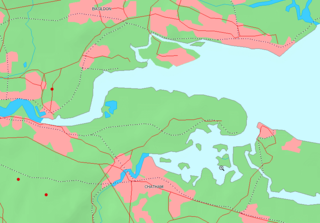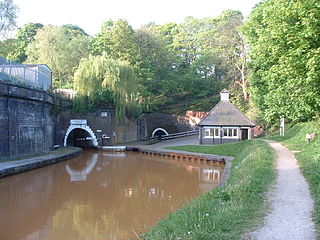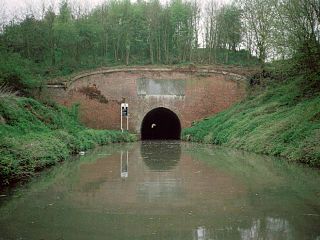
Legging is a method of moving a boat through a canal tunnel or adit containing water. This method of navigating through canal tunnels and adits was commonly used in canal tunnels during the 18th and early 19th centuries.

Legging is a method of moving a boat through a canal tunnel or adit containing water. This method of navigating through canal tunnels and adits was commonly used in canal tunnels during the 18th and early 19th centuries.

Early canal tunnels were built without a towpath as this would require a much larger bore, and hence cost more to build. Prior to the introduction of motorised boats, legging was one of the few options for getting a boat through such a tunnel.
Two people were required. They would lie on a plank across the bows of the boat, and holding the plank with their hands, would propel the boat with their feet against the tunnel wall. This was quite a dangerous activity and resulted in many deaths. [1] In later years 'wing' boards were hooked on to the boat to make the operation safer. At Crimson Hill tunnel, alternate stones in the walls were recessed to provide better tread for the leggers. [2] While the boat was being legged through the tunnel, the horse would be led over the hill.
On short tunnels the legging was done by the boat owner and crew. At long tunnels, professional leggers were available, such as at Blisworth Tunnel and Dudley Tunnel. At the 3 mile long Standedge Tunnel expert leggers could get an empty boat through in 1 hour 20 minutes, taking 3 hours with a full load, for which they were paid 1s 6d. [3]
At Blisworth the boatmen were often terrorised into employing leggers, so in 1827 the leggers were registered and issued with brass armlets for identification. [4]
At Standedge Tunnel, the use of official leggers eventually became a requirement for passage.
At Morwellham, boatmen were said to have pushed against the tunnel roof. This tunnel has a considerable flow of water through it, and progress was very slow in one direction. [5]
Berwick Tunnel on the Shrewsbury Canal, opened in 1797 was the first tunnel to be built with a towpath, negating the need for legging.
Legging was also the main form of propulsion used in the man-made adits in Speedwell Cavern until the boats were given electric motors. Sometimes the guide will switch off the boat's engine and leg along the roof of the cave to demonstrate how the boats used to be worked by miners. They got paid £11.05 in today's money.

A towpath is a road or trail on the bank of a river, canal, or other inland waterway. The purpose of a towpath is to allow a land vehicle, beasts of burden, or a team of human pullers to tow a boat, often a barge. This mode of transport was common where sailing was impractical due to tunnels and bridges, unfavourable winds, or the narrowness of the channel.

The Thames and Medway Canal is a disused canal in Kent, south east England, also known as the Gravesend and Rochester Canal. It was originally some 11 km (6.8 mi) long and cut across the neck of the Hoo peninsula, linking the River Thames at Gravesend with the River Medway at Strood. The canal was first mooted in 1778 as a shortcut for military craft from Deptford and Woolwich Dockyards on the Thames to Chatham Dockyard on the Medway, avoiding the 74 km (46 mi) journey round the peninsula and through the Thames estuary. The canal was also intended to take commercial traffic between the two rivers.

The Chesapeake and Ohio Canal, abbreviated as the C&O Canal and occasionally called the Grand Old Ditch, operated from 1831 until 1924 along the Potomac River between Washington, D.C. and Cumberland, Maryland. It replaced the Potomac Canal, which shut down completely in 1828, and could operate during months in which the water level was too low for the former canal. The canal's principal cargo was coal from the Allegheny Mountains.

A horse-drawn boat or tow-boat is a historic boat operating on a canal, pulled by a horse walking beside the canal on a towpath.

The Huddersfield Narrow Canal is an inland waterway in northern England. It runs just under 20 miles (32 km) from Lock 1E at the rear of the University of Huddersfield campus, near Aspley Basin in Huddersfield, to the junction with the Ashton Canal at Whitelands Basin in Ashton-under-Lyne. It crosses the Pennines by means of 74 locks and the Standedge Tunnel.

The Paw Paw Tunnel is a 3,118-foot-long (950 m) canal tunnel on the Chesapeake and Ohio Canal (C&O) in Allegany County, Maryland. Located near Paw Paw, West Virginia, it was built to bypass the Paw Paw Bends, a six-mile (9.7 km) stretch of the Potomac River containing five horseshoe-shaped bends. The town, the bends, and the tunnel take their name from the pawpaw trees that grow prolifically along nearby ridges.

A canal pound, reach, or level, is the stretch of level water impounded between two canal locks. Canal pounds can vary in length from the non-existent, where two or more immediately adjacent locks form a lock staircase, to many kilometres/miles.

The Standedge Tunnels are four parallel tunnels through the Pennine hills at the Standedge crossing between Marsden in Kirklees, West Yorkshire and Diggle in Oldham, Greater Manchester in northern England. Three are railway tunnels and the other is a canal tunnel. Before boundary changes in 1974, both ends of the tunnels were in the West Riding of Yorkshire.

Blisworth Tunnel is a canal tunnel on the Grand Union Canal in Northamptonshire, England, between the villages of Stoke Bruerne at the southern end and Blisworth at the northern end.

Dudley Tunnel is a canal tunnel on the Dudley Canal Line No 1, England. At about 3,172 yards (2,900.5 m) long, it is now the second longest canal tunnel on the UK canal network today.. However, since the Dudley Tunnel is not continuous this status is sometimes questioned:.

The Foulridge Tunnel is a canal tunnel on the Leeds and Liverpool Canal in Foulridge, Lancashire. Also known as the Mile Tunnel, Foulridge is 1,630 yards long and was built by Samuel Fletcher, following Robert Whitworth's 1789 survey. The tunnel is the longest in the country to allow passage of canoes and kayaks.

Harecastle Tunnel is a canal tunnel on the Trent and Mersey Canal in Staffordshire between Kidsgrove and Tunstall. The tunnel, which is 1.6 mi (2.6 km) long, was once one of the longest in the country. Its industrial purpose was for the transport of coal to the kilns in the Staffordshire Potteries. The canal runs under the 195 m (640 ft) Harecastle Hill near Goldenhill, the highest district in Stoke-on-Trent.

The Sapperton Canal Tunnel is a tunnel on the Thames and Severn Canal near Cirencester in Gloucestershire, England. With a length of 3,817 yards (3,490 m), it was the longest tunnel of any kind in England from 1789 to 1811.

The Dudley Canal is a canal passing through Dudley in the West Midlands of England. The canal is part of the English and Welsh network of connected navigable inland waterways and forms part of the popular Stourport Ring narrowboat cruising route.

The Bruce Tunnel is on the summit pound of the Kennet and Avon Canal between Wootton Top Lock and Crofton Locks in Wiltshire, England.

Butterley Tunnel is a 3,083-yard (2,819 m) disused canal tunnel on the Cromford Canal below Ripley, in Derbyshire, England, opened to traffic in 1794. Along with Butterley Works blast furnaces, part of the canal tunnel and its underground wharf were declared a scheduled monument in 2013.

Norwood Tunnel was a 2,884-yard-long, 9-foot-3-inch-wide (2.82 m) and 12-foot-high (3.7 m) brick lined canal tunnel on the line of the Chesterfield Canal with its Western Portal in Norwood, Derbyshire and its Eastern Portal in Kiveton, South Yorkshire, England.
Standedge is a moorland escarpment in the Pennine Hills of northern England between Marsden, West Yorkshire and Diggle, Greater Manchester. Standedge has been a major moorland crossing point since Roman times and possibly earlier.

The Horseboating Society is a national society, with the primary aim being the preservation and promotion of Horseboating on the canals of Great Britain. The Society was founded on 19 January 2001 at the Ellesmere Port Boat Museum, and it is the only organisation in the UK solely dedicated to horseboating.

A canal tunnel is a tunnel for a canal. The building of a canal tunnel is crucial to help a waterway that is normally used for shipping cross a difficult section of terrain. They are also constructed to reduce the dependency on canal locks.